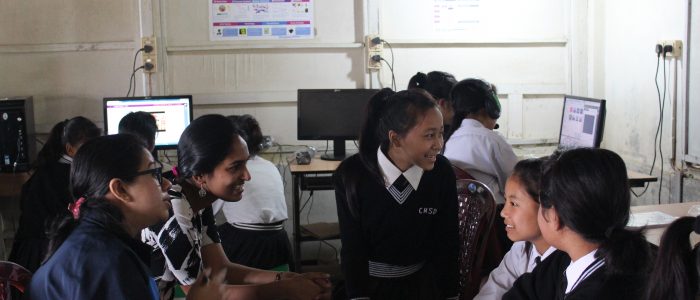Learning to Work with Friends (23.10.17 – 03.11.17)
While learning through computers is widely considered to promote an individualistic classroom culture where students learn from devices on their own, the Connected Learning Initiatives (CLIx) holds that ‘peer learning’ is one of the pillars of learning. How do we imagine peer learning panning out in the classrooms? What are the challenges we face on this front? These are some questions that I will explore in this blog post. My reflections are based on observations made in the classrooms of Mizoram in the months of October – November 2017.
Students working together to create a story using the Open Story Tool
A boy nudges his friend sitting at the terminal next to his, passes on his headphone signalling the friend to listen to what he has recorded in the Let’s Talk activity. His friend does not mind being distracted while engaged in an activity with jumbled words that he is trying to rearrange. He listens to the recording, giggles and approves of the attempt and then goes back to his computer. Both students are quite oblivious to the visitors (Nishevita and I) who are making observations for our research questions. This is a typical CLIx English classroom where interaction is central to language learning.
Peer learning, or collaborative learning, is an essential feature of CLIx rather than the traditional notion of a ‘disciplined’ classroom. Students help each other with the technical process of navigating the platform or explain the story they have just heard to afriend or draw attention to answers to activities.
It is not merely the classroom process but also the design of the modules that encourages interaction. Instructions such as ‘Discuss with you partner and record your answers’ in Let’s Talk and the ‘Reply to’ feature in the Think and Write activity enable discussions with others in the classroom; such features of the platform try to promote peer interaction. Technology need not isolate individuals and put them in shells where they merely learn on their own. It can also enable the processes of learning together and encourage discussions with others.
I noticed a girl writing down in her book new words such as ‘perhaps’ and ‘upset’ that she had come across in a story. Like her, some other students who were familiar with navigating the platform or were relatively comfortable in English preferred working on their own. During interviews, some students said, ‘I am disturbed by friends.’ This tells us that peer learning sometimes has to be consciously facilitated by the adult and students have to be taught the importance of helping each other so that they begin to enjoy learning together. How can this be done? According to Neil Mercer ‘thinking together’ is an approach to develop classroom discussions. Here, he emphasises the need for a set of ground rules that would enable meaningful interactions. Such a shared understanding would also enrich the nature of discussions that a technology platform enables.
Mercer, N.,& Lyn, D. (2008). ‘The value of exploratory talk.’In Mercer, N. & Hodgkinson, S.(Eds.), Exploring talk in school (Ch. 4, pp. 55–71). London, UK: Sage Publications.
Lavanya Murali, Junior Research Associate, English team, CLIx




